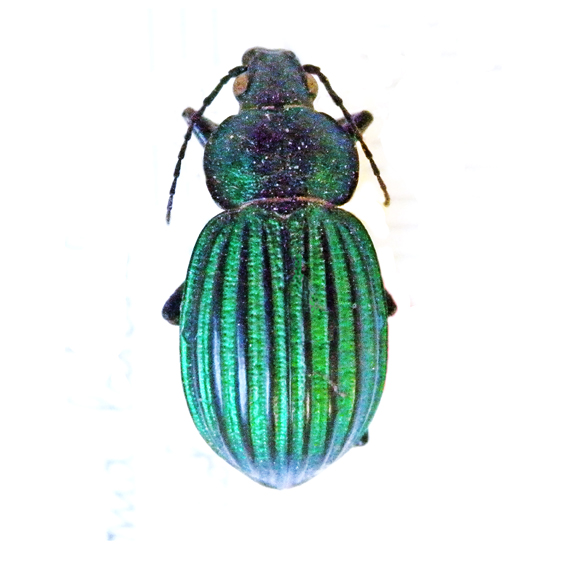Calosoma (Callitropa) viridisulcatum Chaudoir, 1863
Calosoma viridi-sulcatum Chaudoir, 1863: 114 (described from: Mexique intérieur); type material: not stated, description compatible with one specimen only; “holotype” currently in Museum and Institute of Zoology, Warsaw (Mroczkowski, 1960: 377) or in Muséum National d'Histoire Naturelle, Paris (Deuve 1978: 251), ♀ (no locality label) [examined]
Calosoma viridisulcatum var. latesulcatum Oberthur, 1883: pl.1 fig. 3; figurated only, lectotype ♀ designated by Deuve (1978: 254) (locality label: Mexique) in Muséum National d'Histoire Naturelle, Paris [examined]
Calosoma (Blaptosoma) laeve ssp. viridisulcatum Breuning, 1928: 45
Blaptosoma viridisulcatum Lapouge, 1930: 100
Callitropa (Blaptosoma) viridisulcatum Jeannel, 1940: 216
Callitropa (Blaptosoma) viridisulcatum laetulum Jeannel, 1940: 212 (type locality: env. Guadalajara); lectotype ♂ designated by Deuve (1978: 256) in Muséum National d'Histoire Naturelle, Paris [examined]
Calosoma (Blaptosoma) viridisulcatum n. viridilucens Beheim & Breuning, 1943: 22 (type locality: Zacatecas); holotype ♂ and paratype ♀ in Naturalis Biodiversity Centre, Leiden (de Boer, 2002: 119)
Calosoma (Blaptosoma) viridisulcatum Gidaspow, 1959: 278
Calosoma (Blaptosoma) viridisulcatum Erwin, 2007: 107
Calosoma (Blaptosoma) viridisulcatum laetulum Erwin, 2007: 107
Calosoma (Blaptosoma) viridisulcatum viridilucens Erwin, 2007: 107
Blaptosoma viridisulcatum vanderberghei Lassalle, 2009: 10 (type locality: Pto de la Campagna, est de Mascota); holotype ♂ in coll. Lassalle, 24 paratypes in coll. Lassalle and in coll. van den Berghe
Length 24-28 mm. viridisulcatum has on each elytron four black ribs (corresponding to the secondary intervals) and, within each of them, three flattened green bands representing the vestiges of primary intervals.
The color is very variable and this, together with other minor morphological variations, led to description of many individual forms or populations.
Breuning (1928b: 45) and Jeannel (1940: 216) knew C. viridisulcatum only from the surroundings of Guadalajara in the state of Jalisco. Later Beheim & Breuning (1943: 22) described a population from the state of Zacatecas, Gidaspow (1959: 279) indicated a larger distribution including also the states of Querétaro, Nayarit, Colima and Guerrero. Finally Lassalle & van den Berghe (2010: 112), based on more recent researches, specified that C. viridisulcatum is found in the state of Jalisco and that it enters the southern part of the state of Zacatecas. However, it can not be excluded that it spreads beyond the border also into the neighbouring states of Nayarit and Colima. Instead the presence of C. viridisulcatum in Querétaro (Arroyo Seco) and Guerrero (Pacana) seems less probable, and it should also keep in mind the possibility of a mistake since towns with the same names as those mentioned are also found in Jalisco.
Examined specimens and literature’s data
Mexico. Colima: Atentique (Gidaspow, 1959: 279); Jalisco: Guadalajara (Bates, 1891: 223), surroundings of Guadalajara (lectotype of laetulum MNHN), Ixtlahuacán de los Membrillos, Ixtlahuacán del Rio, El Salto (www.inaturalist.org), Jacotepec 1500 m (EM, SB), El Pitahayito 1500 m (EM), Ameca (AVT), Pala (GP), Ajijic, junction on the road to Ameca, Salatitlan, Chapala lake, Tlaquepaque (Gidaspow, 1959: 279), East of Mascota (Lassalle, 2009: 10), Cocula, San Sebastián del Oeste, Atenguillo, Ixtlahuacán del Río, Tlajomulco de Zúñiga (www.inaturalist.org/); Nayarit: Tepic (Gidaspow, 1959: 279); Zacatecas (Beheim & Breuning, 1943: 22): Moyahua de Estrada (TL).
Notes: Brachypterous. Lives in pastures, grassland and cultivated field from 700 to 1600m.. Daytime activity was observed in full sun, the beetle running fast on the ground. Adults are active between June and September, according to Erwin (2007: 107).
 Chaudoir, 1863 Mexique intérieur (holotype) (Muséum National d'Histoire Naturelle, Paris) |
 Chaudoir, 1863 Mexique, Jalisco, env. Guadalajara, Diguet (lectotype of Callitropa (Blaptosoma) viridisulcatum laetulum Jeannel, 1940) (Muséum National d'Histoire Naturelle, Paris) |
 Chaudoir, 1863 Mexique (lectotype of Calosoma latesulcatum Oberthur, 1883) (Muséum National d'Histoire Naturelle, Paris) |
 Chaudoir, 1863 Mexico, Jalisco, 40 km S. Guadalajara, Jacotepec, loc. El Molino m 1500, 12.VII.1987, S. Bruschi leg. |
 Chaudoir, 1863 Mexico, Jalisco, 40 km S. Guadalajara, Jacotepec, loc. El Molino m 1500, 12.VII.1987, S. Bruschi leg. |